|
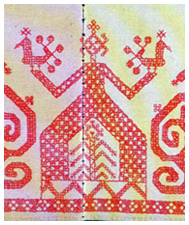 In Russian folklore The Bird carries a lot of meanings. It symbolizes the spring, The Sun itself, and different aspects of The Sun (its warmth, light, and power). Fire essence of the Bird is reflected in fairy-tales of Firebird, and in Russian euphemism for a fire ("a red rooster"). The Bird promises a good harvest and prosperity. The Bird embodies the concept of love, marriage, and motherhood. Therefore, we need to decipher each design in particular to understand its meaning.
In Russian folklore The Bird carries a lot of meanings. It symbolizes the spring, The Sun itself, and different aspects of The Sun (its warmth, light, and power). Fire essence of the Bird is reflected in fairy-tales of Firebird, and in Russian euphemism for a fire ("a red rooster"). The Bird promises a good harvest and prosperity. The Bird embodies the concept of love, marriage, and motherhood. Therefore, we need to decipher each design in particular to understand its meaning.
For the first time, scientists found the design "Mother of the World Holds Birds" in the 10th century's embroidery. In their opinion, it depicts the fall agrarian ritual of releasing birds. The meaning of this ritual is to compensate the energy The Sun spent on creating a harvest. In this case, Birds were thought as sun rays.
Later, in the 11th century, the Peacock motif appeared in Russian embroidery. Scientists think a peacock picture came from Byzantium art to Russia, along with Christianity. The Peacock obviously was a symbol of the sun also. Its long tale feathers were thought as sun rays.
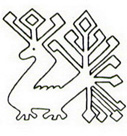
| |
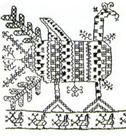 |
|
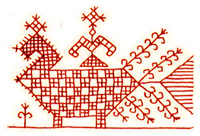 |
Ritual towel.
Tver region,
Bezhetsk dist. | |
Hemline of woman's dress
Olonets region,
1910s | |
Ritual towel
Novgorod region,
1880s |
Different regions developed their own pictures for a peacock. A peacock could be of a different height, width, with a tail of a different shape. It could have a crest on its head (sometimes in a shape of The Sun Wheel). Moreover, designs with Sun Maiden riding the Peacock exist.
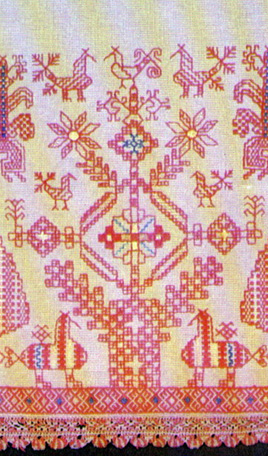 The "Birds by the Tree of Life" motif could be explained through an everyday experience. In a real forest, birds make nests on trees. So, Tree of Life should have Its own birds too. However, a spiritual explanation exists. In Russian paganism, Birds are gatekeepers of Heaven (Eeriy in Russian). They open The Sky Gates in spring, and close them in autumn. So, Birds are heavenly creatures. If they appear by the certain tree at the embroidery, so this tree is a Tree of Life. (By the way, in a decoration of women's headdresses, bride's shirts, and village wooden houses, Birds are placed in the top ("heavenly") level of a design).
The "Birds by the Tree of Life" motif could be explained through an everyday experience. In a real forest, birds make nests on trees. So, Tree of Life should have Its own birds too. However, a spiritual explanation exists. In Russian paganism, Birds are gatekeepers of Heaven (Eeriy in Russian). They open The Sky Gates in spring, and close them in autumn. So, Birds are heavenly creatures. If they appear by the certain tree at the embroidery, so this tree is a Tree of Life. (By the way, in a decoration of women's headdresses, bride's shirts, and village wooden houses, Birds are placed in the top ("heavenly") level of a design).
Images of The Swan and The Goose on women's headdresses and costumes are caused by the worship of waterfowls in Northern Russia. Scientists believe such worship was established in Neolithic Age. Northern Russia's arts and crafts are full of Swans and Geese. Birds appear not only on clothes, but also as an element of a decoration of houses, spinning-wheels, and harnesses.
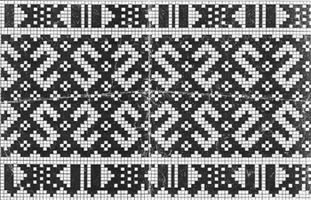 | |
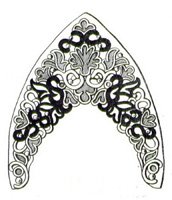 |
Wedding plat
Perm region,
Perm dist. | |
Headdress
Yaroslavl region,
1780s |
Golden embroidered "swans" were used for brides' headdresses. Pairs of waterfowls symbolized a wish of a happy marriage with a lot of children. Besides, pairs of swans embellished wedding belts and plats - ritual towels-talismans. Ornaments with swans and geese often included a symbol of water (zig-zag or wave line) at the bottom.
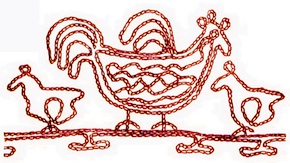 One more bird using in the traditional embroidery is Hen. Slavs hallowed a hen as a symbol of women's fertility and child-bearing power. Hens embellished outfits of married women. Besides, a name for women's headdress was revealed from a word "hen": kokoshnik (kokosh = a hen in ancient Slavic language).
One more bird using in the traditional embroidery is Hen. Slavs hallowed a hen as a symbol of women's fertility and child-bearing power. Hens embellished outfits of married women. Besides, a name for women's headdress was revealed from a word "hen": kokoshnik (kokosh = a hen in ancient Slavic language).
Two types of a hen-related pattern exist. First is "A Hen with Chicken". Second type shows one large bird with several smaller ones inside ("pregnancy"). Both designs are clear: they are "graphic spells" for fertility.
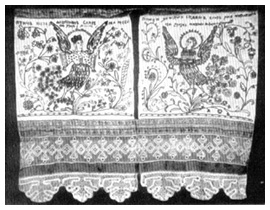 In Russian mythology there is a double-nature character, Sirin. It is a half-bird, half-woman. Village people started to use this image in their embroidery not earlier than in the 18th century. Craftswomen purled Sirin on velvet headdresses, linen towels, cotton bedcloth. Sirin often combines with pictures of trees and flowers. Also, such a designs bear some embroidered quotations from myths.
In Russian mythology there is a double-nature character, Sirin. It is a half-bird, half-woman. Village people started to use this image in their embroidery not earlier than in the 18th century. Craftswomen purled Sirin on velvet headdresses, linen towels, cotton bedcloth. Sirin often combines with pictures of trees and flowers. Also, such a designs bear some embroidered quotations from myths.
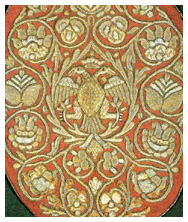 By the end of the 19th century, in urban-style embroidery a new "bird" design appeared. It was a two-headed eagle (Russian coat of arms). In fact, a two-headed bird existed in a traditional embroidery (as a version of
The Sun Boat). So, two-headed eagle was accepted by village people easily. However, at the beginning of the 20th century people started to forget the language of symbols. And, two-headed eagle replaced
"pretty frogs" (Ladies of Fertility) at women's headdresses, just because of a similar shape.
By the end of the 19th century, in urban-style embroidery a new "bird" design appeared. It was a two-headed eagle (Russian coat of arms). In fact, a two-headed bird existed in a traditional embroidery (as a version of
The Sun Boat). So, two-headed eagle was accepted by village people easily. However, at the beginning of the 20th century people started to forget the language of symbols. And, two-headed eagle replaced
"pretty frogs" (Ladies of Fertility) at women's headdresses, just because of a similar shape.
|










